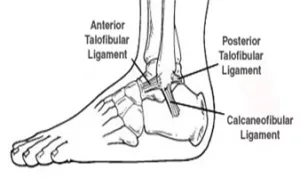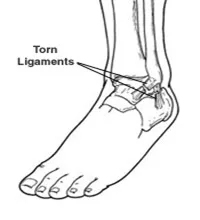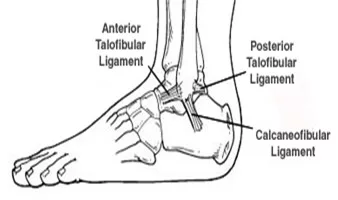An ankle sprain refers to an injury involving one or more ligaments in the ankle, typically on the outer side. Ligaments are like strong bands of tissue, akin to rubber bands, connecting bones and stabilizing joints. Within the ankle joint, ligaments play a vital role in preventing excessive side-to-side movement.
The severity of an ankle sprain can vary, depending on whether the ligament is stretched, partially torn, or completely torn. It’s important to distinguish ankle sprains from strains, which affect muscles, not ligaments.
Causes
Ankle sprains often result from incidents such as falls, sudden twists, or blows that force the ankle joint out of its normal position. They can occur during sports activities, when wearing improper footwear, or while walking or running on uneven surfaces. In some cases, individuals with naturally weak ankles or those who have had previous ankle or foot injuries may be more prone to sprains.
Symptoms
Common symptoms of ankle sprains include:
- Pain or soreness
- Swelling
- Bruising
- Difficulty walking
- Stiffness in the joint
Ankle fractures are frequently occurring injuries primarily attributed to the inward or outward rolling of the ankle. It’s not uncommon for individuals to confuse an ankle fracture with an ankle sprain, even though these conditions are distinct and necessitate precise and prompt diagnosis. Occasionally, they can happen concurrently.
Ankle Fractures vs. Sprains
Ankle fractures and sprains are distinct injuries, often confused due to their similar symptoms. Prompt and accurate diagnosis is crucial because they may sometimes co-occur.
Why Prompt Medical Attention Matters
Timely evaluation and treatment by a foot and ankle surgeon are essential for several reasons:
- Preventing Chronic Ankle Instability: Neglecting an ankle sprain can lead to chronic ankle instability, characterized by persistent discomfort and a tendency for the ankle to give way. Leg weakness can also develop over time.
- Detecting Additional Injuries: A severe ankle injury, such as a bone fracture, might accompany the sprain and could lead to complications if left untreated.
- Addressing Unnoticed Foot Injuries: Ankle sprains may sometimes coincide with unnoticed foot injuries that require attention.
- Early Rehabilitation: Starting ankle sprain rehabilitation promptly is critical. Delayed rehabilitation may hinder proper healing.
Diagnosis
The foot and ankle surgeon will collect a comprehensive history of your symptoms and perform a thorough examination. Advanced imaging studies, such as X-rays, may be ordered to assess the injury’s severity.
Nonsurgical Treatment
For ankle sprains, rehabilitation is a vital aspect of treatment. Below are some recommendations your foot and ankle surgeon may suggest
- Rest: Avoid putting weight on the injured ankle to prevent further harm.
- Ice: Apply an ice pack to the affected area with a thin towel in between, using it for 20 minutes, then waiting at least 40 minutes before reapplying.
- Compression: Consider an elastic wrap to control swelling.
- Elevation: Keep the ankle slightly elevated above heart level to reduce swelling.
- Early Physical Therapy: Start a rehabilitation program as soon as possible, including prescribed exercises.
- Medications: Nonsteroidal anti-inflammatory drugs (NSAIDs), like ibuprofen, may be suggested to alleviate pain and inflammation. In some cases, prescription pain medications may be necessary for sufficient relief.
When Is Surgery Necessary?
In more severe cases, surgery may be required to effectively treat an ankle sprain. Surgical procedures often involve repairing damaged ligaments. The choice of procedure depends on the type and severity of the injury and the patient’s activity level.
Following surgery, rehabilitation is of utmost importance. Completing the rehabilitation program is essential for a successful recovery. Regular follow-up visits with your foot and ankle surgeon during this period ensure proper healing and the restoration of function.




